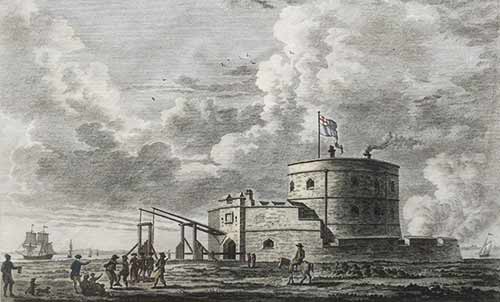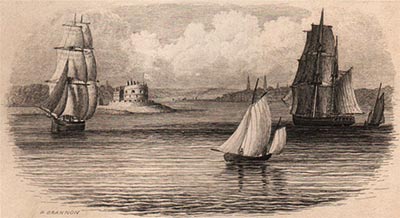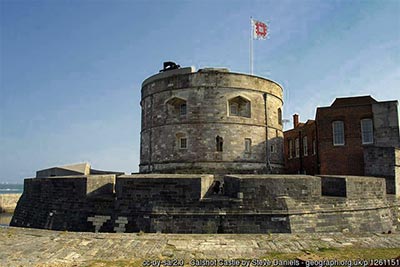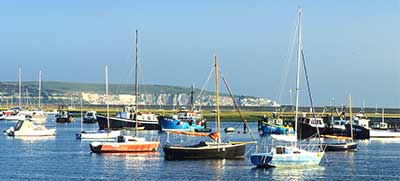Calshot Castle
Calshot Castle was built during the reign of Henry VIII as an artillery fort. Located on a narrow, sand and shingle spit near Fawley, on the north shore of the Solent close to where it is joined by Southampton Water, the castle was designed to defend the sea passage to Southampton and other anchorages north of the Isle of Wight.
(1) Construction and the early years

Constructed between 1539 and 1540, Calshot Castle was one of a number of coastal defences built at around this time to counter possible invasion following the beginning of the English Reformation, a period during which England broke away from the authority of the Pope and the Roman Catholic Church.
High on the list of potential aggressors was staunchly Catholic France, motivated by a desire to right what was considered to be a religious wrong by re-establishing the Pope's authority, and also by territorial ambitions. Indeed, encouraged by the Pope, invasion at this time by the French seemed inevitable.
Henry was well aware of the threat and acted quickly, commissioning many new coastal fortifications. Those intended to defend the approaches to Southampton Water included Calshot Castle; Hurst Castle, a little to the west along the coast from Calshot; and fortifications at Netley and St Andrew's, on the Hamble River. Newly constructed blockhouses at East and West Cowes, and the castle at Yarmouth, all on the Isle of Wight, at least in part, served the same purpose.
Conveniently available stone and lead from Beaulieu and Netley Abbeys - which were largely demolished following the Dissolution of the Monasteries (1536 - 1541) which allowed Henry and his favourites to seize control of many religious houses - were probably used in the construction of the castle.
(The builders of Hurst Castle similarly used materials from Beaulieu Abbey, whilst at Yarmouth Castle, masonry from Quarr Abbey, near Ryde, was used).
Calshot Castle comprises a prominent central gun-tower, or keep; a surrounding low, continuous, circular curtain wall separated from the keep by a courtyard; a gatehouse and a shallow stone-lined moat crossed by a bridge that originally could be raised.
It was quite heavily armed with a garrison of 16 men and up to 36 artillery guns, but in the event, invasion did not materialise and the fear of invasion had largely passed before completion of all the structures in the chain of defences.
(2) 18th and 19th century alterations

By 1559 there were only ten serviceable weapons and, whilst the fabric of the structure was maintained and a garrison was present, little of note occurred until modifications were made in late 18th century. Then, starting in 1774, the layout of the gatehouse was altered and took on much of its present form, and it was possibly also at this time that the original curtain wall was lowered.
By the early 19th century, Calshot's defensive role had substantially diminished and for much of the remainder of the century it was used as a base from which to combat smuggling and as general quarters for the coastguard service.
But by the 1880s, the French navy was threateningly being equipped with newly developed, fast torpedo boats that could not easily be countered by existing, guns on warships, guns that could only fire one round every few minutes. Consequently, 'quick firing' weapons were developed that were initially installed on warships.
Fears grew, however, that, as torpedo boats increased in size, flotillas of such craft would be difficult for the Royal Navy to tackle, and that there was therefore a risk of great damage being inflicted on British shipping, ports and harbours.
Consequently, in 1894, control of Calshot was handed to the War Office and the castle, along with some of the other coastal forts, was equipped with 'quick firing' guns and searchlights. Necessary alterations were undertaken - openings through which guns were fired on the north-eastern side of the courtyard were adapted for searchlights; oil powered generators were installed in the basement of the keep; the two floors above provided barrack accommodation; a guardroom, cookhouse and storeroom were created; and a separate gun battery built to the south of the castle, of which nothing now remains - the weaponry was removed during the First World War and the associated structures by the late 1920s.
Such was the perceived threat to Southampton at this time that, to augment the guns and searchlights, a boom defence system was also strung out from a little to the north-east of the castle right the way across the mouth of Southampton Water.
Designed to prevent surface craft from passing, the boom initially consisted of a line of disused ships secured stem to stern across the navigable section of the channel, linked to wood and metal towers known as 'dolphins' that were armed with two 12 pounder 'quick firing' guns and a machine gun. A lighter, specially constructed boom, in 1909 replaced the earlier, less portable version and probably remained in use until the end of the First World War in 1918.
(3) The 20th century

Other changes to the castle - the last of any consequence - occurred in 1907 when amongst other things, the keep roof was altered and strengthened to accommodate a pair of 12 pounder 'quick firing' guns. A 1910 action plan spelt detailed continued use of the castle for defensive purposes but by the outbreak of the First World War in 1914 Calshot Spit was more known as a seaplane base.
Following the Second World War, the castle was once again used to provide coastguard accommodation until the nearby coastguard lookout tower was opened in 1974.
The castle is now in the care of English Heritage and has been open to the public since the 1980s. It is a Grade II* listed building. Full details of admission charges and opening times are available from English Heritage. Parking is available nearby.
References:
Calshot Castle: English Heritage
Quick links
More links
Search this site

